
Speakers and Presentations
|
| TUESDAY, NOVEMBER 16 |
| 1:00 p.m. |
Welcome/Expectations, Beth Nelson, Midwest Forage Association |
|
 |
The Midwest Forage Association is dedicated to creating, promoting and supporting value to the forage industry through leadership, research and education to improve profitability
for users and producers of forage crops emphasizing environmentally sound systems. MFA allows greater synergies across state lines through its regional concept, broadening the appeal to forage producers in the Midwest and increasing efficiency in order to establish
critical mass. MFA offers members a wide range of forage related research and information, while heightening the visibility of our forage industry at the regional and national level. |
| 1:15 p.m. |
Grass & Grass/Legume Mixture Research Update, Paul Peterson, University of Minnesota |
|
 |
Alfalfa and corn silage are the primary forages fed in total mixed rations (TMRs) for dairy cows in Minnesota and the North Central Region as a whole, largely because of their high
yield and forage quality potentials. Grasses have usually played a lesser role, and have been less appreciated for their capacity to contribute to farm profitability. However, during the last decade, interest in forage grasses for pasture, hay and haylage has been increasing, but data and experience to determine when and how grasses can best benefit forage and dairy
production enterprises are lacking. This session will provide an update on recent and ongoing research on grass and grass/legume forage potentials. |
| 1:45 p.m. |
Forage Crop Insurance Options for 2011 & Beyond, Kevin Erickson, Risk Management Agency |
|
 |
This presentation will include an overview of the different crop insurance products currently
available for forage in Minnesota, Wisconsin, and surrounding states. The forage products reviewed will be APH forage production, GRP forage production, Dollar Plan Forage Seeding
and the pilot program for Pasture, Rangeland and Forage (PRF). Some pros and cons of each product will be discussed including individual coverage versus county coverage, record
keeping requirements and average premium costs associated with each product. The expansion of PRF for 2011 will be presented as well as proposed expansion of the product for 2012. |
| 2:15 p.m. |
Alfalfa Sulfur Survey, Jerry Clark, University of Wisconsin |
|
 |
Over the past two years, field agronomists have been reporting to UW Extension County
Agents and Specialists more cases of suspected sulfur (S) deficiency in Southern Wisconsin. This observation is born out by data from alfalfa samples submitted to the UW Soil and Plant
Analysis Lab. In 2009, 85% of alfalfa samples submitted as abnormal looking were low in S(<0.25% S), while 44% of the normal looking samples were low in S (Laboski, 2009). Having
a better understanding of the nutritional status of alfalfa across the state of Wisconsin is one component to assisting farmers in profitably producing a high yielding and good quality
alfalfa crop. |
| 2:45 p.m. |
The Wisconsin Alfalfa Yield & Persistence Project, Mike Rankin, University of Wisconsin |
|
 |
It has always been difficult to obtain alfalfa yields from production fields because of time
constraints associated with weighing large amounts of forage during the harvest. In the past five years, many larger dairies have installed “on farm” scales, which make yield determinations
feasible over entire fields without incurring large harvest delays. In doing so, this project helped quantify forage yield, quality and persistence of production alfalfa fields over a range
of Wisconsin locations and management systems. |
| 3:30 p.m. |
USDA-ARS Plant Science Research Unit-St. Paul Alfalfa/Forage Program, Deborah Samac, USDA-ARS |
|
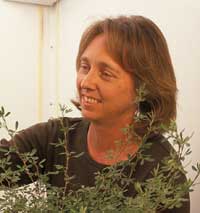 |
The USDA Agricultural Research Service St. Paul, MN, location comprises three Units: Cereal
Disease Laboratory (CDL), Plant Science Research (PSR) and Soil & Water Management Research (SWMR). The mission of the PSR is to develop new knowledge that expands understanding
of the fundamental processes controlling increased production, improved quality and enhanced use of alfalfa, oat and wheat and to utilize this knowledge to develop germplasm
and crop management schemes that lead to increased farm profitability and sustainability of the nation’s resource base. Dr. Samac will review the latest activities of the Alfalfa/Forage
program of the Plant Science Research Unit. |
| 4:00 p.m. |
USDA Conservation Programs for Forage Producers, Paul Flynn, USDA-NRCS |
|
 |
USDA, through the Natural Resources Conservation Service (NRCS) offers programs, to assist
landowners and farm operators, to protect and enhance natural resources on their lands. NRCS has programs offering technical assistance to evaluate and identify resource issues
for soil, water, plant, and livestock needs. Through implementation of the 2008 Farm Bill, there are several programs through which financial assistance can be obtained. Each year
the Minnesota NRCS receives funding through these programs to provide opportunities to implement conservation practices and activities to protect our natural resource base and the
environment. Learn about these NRCS Programs: EQIP, CSP, GRP, CRP, and WRP. |
|
| WEDNESDAY, NOVEMBER 17 |
| 8:30 a.m. |
Sorghum: A Potential Forage & Biomass Crop in ND, Marisol Berti, North Dakota State University |
|
 |
Twenty-two sorghum varieties of different types were seeded in the spring 2010 at Fargo and
Prosser, ND, locations in an RCBD with three replicates. Experimental units had six rows 30 centimeters apart and five meters in length. Two harvests were conducted in all plots; plant
height yield and quality were evaluated. Biomass yield was determined on each experimental unit and wet chemistry analysis was conducted to determine the chemical composition
including crude protein (CP), acid detergent fiber (ADF), neutral detergent fiber (NDF) and acid detergent lignin (ADL). |
| 9:00 a.m. |
Roundup Ready® Alfalfa Update, Matt Fanta, Forage Genetics International |
|
 |
This update will include a historical and current perspective following the initial usage and
legal case surrounding Roundup Ready Alfalfa technology. In addition, an overview of other alfalfa technology improvements in development specifically related to plant quality and
agronomics will be discussed. |
| 9:30 a.m. |
Midwest Forage Research Program (MFRP) Roundtable Discussion/Reports
Roundtable Breakout Groups:
- Beef
- Commercial Hay
- Dairy
|
|
|
|
| WEDNESDAY, NOVEMBER 17 (Concurrent sessions) |
| 1:30 p.m. |
Alfalfa Genomics: Importance to Sustainability & Ecological Services, Carroll Vance, USDA-ARS |
|
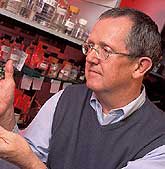 |
Alfalfa is highly effective in symbiotic N fixation. The amount fixed per growing season ranges
from ~70kg/ha-175kg/ha, depending on variety and environment. Symbiotically fixed N can provide a useful N source for subsequent crops, resulting in a significant fertilizer savings.
Genetic and genomic data have shown there are hundreds of genes contributing to the process of nodulation and N fixation. The functional significance of many of the genes involved
in symbiotic N fixation has been identified. Yet we have been unable to directly improve the process. In this presentation current advances in symbiotic N fixation will be discussed. |
| 1:30 p.m. |
Alfalfa/Grass Mixture Forage Quality on Minnesota Farms, Jim Paulson, University of Minnesota |
|
 |
Forage Quality Summary. Binary mixtures of three different alfalfa varieties were seeded with
two varieties of each of nine perennial cool-season grass species in replicated small plots on three Minnesota farms at: Underwood and Hutchinson (Aug 2008) and Avon (May 2009). Alfalfa
was seeded alone at all sites; several red clover/grass and birdsfoot trefoil/grass mixtures were seeded in 2010 (Underwood and Hutchinson) and in 2010 (Avon). Subsamples of flail-chopped
herbage of selected treatments were oven-dried, ground and analyzed for forage quality via NIRS Consortium equations at the UW-Marshfield. Parameters include CP, NDF, 48-hr NDF
digestibility, ADF, and ADL. RFQ, RFV, milk per ton and milk per ac were also tested. |
| 2:00 p.m. |
Alfalfa: A Companion Crop with Corn for Bioenergy, Hans Jung, USDA-ARS |
|
 |
Corn grain-based ethanol is the major form of biofuel production in the U.S. However, there are
concerns about growing corn in rotation with soybean or as a continuous corn crop for ethanol, including high energy inputs, high soil erosion potential and high nutrient inputs and loss to the
environment. Concerns have also been raised about diversion of grain from food and feed uses to bioenergy production, and land use shifts from set-aside programs like CRP to corn production.
Incorporating alfalfa into rotation with corn offers an opportunity to maintain biofuel production and alleviate the negative impacts related to continuous corn production. At the same time, this
crop rotation would fulfill the food and feed needs for starch and protein. |
| 2:00 p.m. |
Reductions in Potash for Last-Year Alfalfa Production, Matt Yost, University of Minnesota |
|
 |
Applying the correct amount of potassium (K) fertilizer is critical for alfalfa yield and stand
persistence; however, stand persistence is often not a major concern in the last year of alfalfa production; therefore, last-year K fertilizer response of alfalfa in its third or fourth full year of
production was tested on 10 farms in Minnesota with medium soil-test K (STK) levels (80-120 ppm) in 2008 and 2009. Yield increased slightly with early spring application but did not respond
if K was delayed until after first harvest. NDFD and ADF increased with either application time, but RFV and RFQ were not improved. We found no benefits to applying potash in the last year
of alfalfa production when STK was greater than 80 ppm at the beginning of that season. |
| 2:30 p.m. |
Optimal Biomass Crop Options Vary with Landscape Position, Gregg Johnson, University of Minnesota |
|
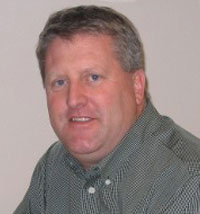 |
In order to advance the use of biomass crops as a feedstock for a wide range of bio-industrial
applications, it is essential that we optimize the placement of crops at the field scale in a way that will maximize overall productivity and profitability while addressing critical environmental and
ecological issues. The value gained by selective placement of dedicated biomass crops will come from an understanding of how crop growth and productivity is influenced by terrain, soil properties,
and other attributes. We will present information from field research exploring 1) differences in plant growth and development between biomass types as a function of landscape position and 2) the
relationship between plant growth and the environment across seven landscape positions. |
| 2:30 p.m. |
Orchardgrass vs. Alfalfa for Replacing Dairy-Cow Grain, Mary Raeth-Knight, University of Minnesota |
|
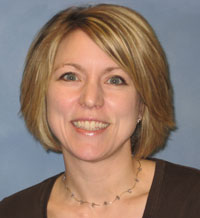 |
Alfalfa is currently the predominant forage fed to lactating dairy cows in the Midwestern
U.S.; however, interest in incorporating grasses into lactating dairy cow diets has recently been rejuvinated. Due to differences in chemical composition and physical characteristics of
grasses and legumes, directly comparing the feeding value of alfalfa to grasses in the diet is challenging. Therefore, the study objective was to use linear regression analysis to compare
the change in lactating dairy cow performance when increasing amounts of corn grain and soybean meal were replaced with alfalfa or orchardgrass hay in a total mixed ration. |
| 3:30 p.m. |
Lamb & Cow Performance When Fed Corn Silage with Reduced Ferulate Cross Linking, Hans Jung, USDA-ARS |
|
 |
Ferulate-mediated lignin/hemicellulose cross linking in grasses reduces in vitro NDF
digestibility (IVNDFD). Impact of ferulate cross linking on animal performance was examined in lamb digestibility and dairy cow performance trials using the seedling ferulate ester (sfe)
corn mutant that reduces cross linking and improves IVNDFD. Digestibility of sfe silages was not different from the control silage; however, lambs were less selective against fiber when
fed sfe silages. Intake and milk production were greater for cows fed the sfe containing diets and cows were less selective against fiber. |
| 3:30 p.m. |
Grazing Windrowed vs. Stockpiled Annual Ryegrass, Jolene Kelzer, University of Minnesota |
|
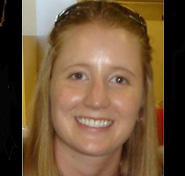 |
Windrowed and stockpiled annual ryegrass as fall grazing systems were evaluated for forage
quality and beef cow performance over two years. Angus beef cows were randomly assigned to one of two grazing systems: 1) stockpiled annual ryegrass (STO), and 2) windrowed annual
ryegrass (WIN). Forage CP, ADF and NDF were greater over time, whereas TDN and RFV were lower over time for WIN vs. STO forage for both years. Cows on STO grazed 8 and 10 days longer
in 2007 and 2008. Total BW gain and ADG were similar in 2007; however, BW gain and ADG were greater for STO than WIN in 2008. Although forage quality is affected, stockpiled and windrowed
annual ryegrass may both be viable fall grazing systems. |
| 4:00 p.m. |
Aphanomyces Root Rot of Alfalfa, An Evolving Story, Dean Malvick, University of Minnesota |
|
 |
Aphanomyces root rot causes poor stand establishment and reduced persistence of alfalfa, primarily
in poorly-drained soils. Although this disease has been known since the 1980’s, its distribution in the Midwest and new information on its biology that are important for management are still being
revealed. The causal pathogen is a soilborne fungus-like organism that exists in the form of at least two races. Both races are widespread in the Midwest and race 2 appears to be more common in
many areas. Recent work has indicated that populations of Aphanomyces euteiches in alfalfa fields are diverse, often composed of both races, and can infect and create risk for multiple cultivated
and native legume species. |
| 4:00 p.m. |
Methods to Establish Annual Forages on Cattle Winter Feeding Areas, Russ Mathison, University of Minnesota |
|
 |
Winter feeding areas for cattle typically create manure build-up that is often unutilized for
growing forages and can cause some concerns with manure-contaminated runoff. Research, on two producer farms and UM-Grand Rapids plots, evaluated forage establishment on cattle
winter feeding areas. Research evaluated three methods to establish two annual crops. Annual ryegrass (AR) and sorghum-sudangrass (SS) were broadcast (B), interseeded (I) or drilled
into a conventionally (C) prepared seedbed. Establishment success varied across locations and species. Generally, AR and SS establishment was successful under the conventional and
interseeding methods. |
| 4:30 p.m. |
Alfalfa Variety Management & Research, Craig Sheaffer, University of Minnesota |
|
 |
For profitable alfalfa production, there are many variables: variety selection, fertilization,
establishment, pest control and harvest management. Successful stand establishment is critical due to the long-term nature of alfalfa production. Two primary establishment strategies
consist of seeding with or without a companion crop. Interactive goals of yield, quality and stand persistence influence harvest management. Understanding alfalfa’s morphological
development from vegetative through floral stages and its relationship to yield, quality, carbohydrate reserves and erosion control is critical to developing a production strategy. |
| 4:30 p.m. |
Pastures & Cows in Low-Input Dairy Systems, Dennis Johnson, University of Minnesota |
|
 |
The focus of research in dairy at the West Central Research and Outreach Center has been
grazing, sustainability and organic systems. This presentation will include research on
renovation, fertilization, adaptable forage species, outwintering and grazing management
from a systems perspective. |
|
| THURSDAY, NOVEMBER 18 (Concurrent sessions) |
| 8:30 a.m. |
Alfalfa/Grass Mixture Yield Performance on Minnesota Farms, Nathan Winter, University of Minnesota |
|
 |
Agronomic Summary. Binary mixtures of three alfalfa varieties were seeded with two varieties
of each of nine perennial cool-season grass species in replicated small plots on three Minnesota farms: Underwood and Hutchinson (Aug 2008) and Avon (May 2009). Alfalfa was seeded alone
at all sites; several red clover/grass and birdsfoot trefoil/grass mixtures were seeded at Avon for comparison. Plots were harvested three to four times per year to a four-inch residual in 2009 and
2010 (Underwood and Hutchinson) and in 2010 (Avon). Legume, grass and weed contributions to yield were visually estimated at each harvest. To date, mixtures of alfalfa with orchardgrass or
tall fescue are highest yielding. At Avon, red clover/grass mixtures are yielding well. |
| 8:30 a.m. |
It's Still True: Plowing Up Alfalfa Releases Plenty of N for Corn, Michael Russelle, USDA-ARS |
|
 |
Farmers and their advisors question the accuracy of published fertilizer N replacement values
that alfalfa provides to first-year corn. Their skepticism has risen as corn yields have increased, but higher fertilizer prices have heightened the need to trim unproductive inputs. Recent
Minnesota data confirm reports in the literature – corn rarely responds to extra N after good stands of alfalfa are tilled in. Corn also allows the soil to recharge with fall and spring rain,
promoting leaching. Adding extra N reduces your bottom line and leaves too much nitrate in the crop and soil, threatening herd health and water quality. After good alfalfa stands (4+ plants
per square foot) are plowed down, limit N application to first-year corn to starter N only. |
| 9:00 a.m. |
Using Genomics to Develop Alfalfa as a Biomass Crop, John Gronwald, USDA-ARS |
|
 |
Alfalfa has potential as a biomass crop for cellulosic ethanol production. Our model involves
using leaves as a protein supplement for livestock and stems for ethanol production. Modifying cell wall composition of alfalfa stems (increasing cellulose, decreasing lignin) would advance
the development of alfalfa as a cellulosic feedstock. We are using genomics (gene arrays, highthroughput sequencing) to compare gene expression in alfalfa plants that differ in amount of
cellulose and lignin in stems. This approach will identify key genes regulating cellulose and lignin production in alfalfa stems and thereby speed up the development of high cellulose/
low lignin cultivars. |
| 9:00 a.m. |
Soil N to Corn After Alfalfa Through Tillage & Regrowth Management, Jeff Coulter, University of Minnesota |
|
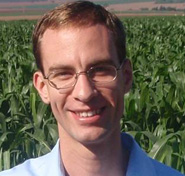 |
Planting corn after alfalfa can greatly reduce the N fertilizer requirement for first-year corn while
increasing corn yield potential due to rotation effect. Current UMN guidelines regarding alfalfa N credits to corn are based on alfalfa stand density and do not account for the quantity of alfalfa
regrowth prior to stand termination or the tillage system used. In 2009, field experiments were established on six farms in Minnesota to determine how the quantity of alfalfa regrowth and
tillage system for alfalfa stand termination affect the response of first-year corn to N fertilizer. Chisel plow, minimum- and no-tillage systems were evaluated. Results from these experiments
will be shared, along with herbicide recommendations for successful alfalfa stand termination. |
| 9:30 a.m. |
Forages’ Role in Climate Change Mitigation: Preventing Erosion & Soil Carbon Loss, John Baker, USDA-ARS |
|
 |
Congress has mandated a substantial increase in the production of renewable fuels, and
much of that may come from crop residues, particularly corn. Massive removal of corn stover could cause increases in soil erosion and loss of soil organic matter. To avoid this,
we are testing two cropping systems: aerial seeding of winter rye into standing corn and companion cropping of corn with kura clover. The latter appears to have more promise,
particularly because of the N-fixing capability of the clover and its rhizomatous growth habit, which favors soil carbon sequestration. |
| 9:30 a.m. |
Reducing Crown & Root Diseases of Alfalfa for Improved Yield & Stand Life, Deborah Samac, USDA-ARS |
|
 |
Brown root rot of alfalfa was found to be widespread in Minnesota, Wisconsin and other
northern tier states. The pathogen increases on corn and soybean residue while annual small grains and canola reduce the pathogen population in soil. Several commercial alfalfa varieties
show good persistence in areas with high disease pressure. Identification and current research on Mycoleptodiscus crown and root rot will be described. |
| 10:30 a.m. |
Prairie Establishment Methods to Resist Invasion by Canada Thistle, Roger Becker, University of Minnesota |
|
 |
During establishment, prairies and forage plantings are vulnerable to invasion by undesirable
species. We tested methods to exclude invasion using Canada thistle as the model invasive weed. Fall planting appeared most conducive to establishment of Canada thistle seedlings,
summer planting intermediate, and spring planting the least. Cool season plantings dominated by native grasses were more resistant to invasion than warm season plantings, and cool/warm
season mixtures. Warm season plantings initially had a high percentage of bare ground open to invasion. Clopyralid treated plots initially had more native grass cover and fewer Canada
thistle plants, but these differences diminished with time. |
| 10:30 a.m. |
Soil Quality Benefits of Alfalfa in Corn-Soybean Cropping Systems, Deborah Allan, University of Minnesota |
|
 |
Soil biological and physical properties and carbon and nitrogen cycling were measured in
two and four year corn-soybean rotations at the Southwest Research and Outreach Center in Lamberton, MN. Effects of alfalfa in the rotation will be discussed. |
| 11:00 a.m. |
Alfalfa Weevil: Does the Old Management Plan Still Work?, Phil Glogoza, University of Minnesota |
|
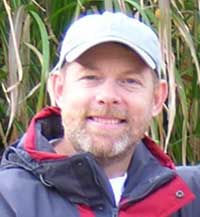 |
Recent frustrations with alfalfa weevil have growers puzzled as to what is happening with
weevil management strategies. Has the biology changed? Have aggressive control programs disrupted some natural balance? Is it time to re-visit management strategies? The discussion
will take a look at recent patterns of weevil population development. It is also time to identify growers’ frustrations by reviewing their current management approaches. |
| 11:00 a.m. |
Grass Variety Development & Performance Testing, Dwight Tober, USDA-NRCS |
|
 |
The USDA-NRCS Plant Materials Center (PMC) located at Bismarck, ND, develops and
evaluates grass varieties for conservation use in the Northern Great Plains and Upper Midwest. Both native and introduced grass species are performance tested in replicated
trials and demonstration plots. New varieties and germplasms (native) are released for use in this area. This presentation will prodvide a brief overview of the Bismarck PMC, evaluation
trial summary information, foundation grass seed production, new varieties, species/variety recomendations and publications that are available from the Bismarck PMC. |
| 11:30 a.m. |
Tall Fescue Forage Potential for Minnesota, Paul Peterson, University of Minnesota |
|
 |
Tall fescue is the most widely grown cool-season perennial forage grass in the U.S. To date,
however, its use has been primarily in mid-latitude states. Research in the northeastern US, Wisconsin and Minnesota have documented its potential in the northern U.S. Tall fescue is
among the highest-yielding cool-season grasses available. It is tolerant to a broad range of environmental and soil conditions and utilization strategies including silage, pasture and hay.
It also mixes well with alfalfa. Recent University of Minnesota tall fescue performance data will be presented and recommendations discussed. |
| 11:30 a.m. |
Effects of Replacing Conventional Corn Silage with BMR Corn Silage, Noah Litherland, University of Minnesota |
|
 |
Previous research has shown that the (lignin reducing) brown mid-rib mutation in corn silage
did not increase fiber digestibility, but did increase nutrient intake and milk production. The objectives of this experiment are to evaluate the effects of increased fiber digestibility
and rate of passage on feed intake and milk yield of high yielding dairy cows by feeding an increasing proportion of low lignin corn silage. Results from this study will be useful
in determining the amount of change in in vivo fiber digestibility necessary to improve nutrient intake and milk production. |




